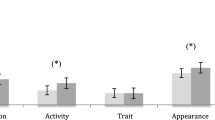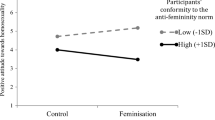Abstract
When confronted with males and females deviating from society's sex-based gender role prescriptions, people tend to respond more negatively to the males' transgressions. In order to develop an understanding of the reasoning behind this phenomenon, two theories were tested. The social status model predicts that males are punished because feminine behavior is lower in status than masculine behavior. The sexual orientation hypothesis predicts that, for males, there is a stronger perceived link between gender roles and sexuality and that a male acting in a feminine way is more likely to be considered a homosexual than a female acting in a masculine way. A group of mostly Caucasian participants were asked to rate a male or female target, performing in either a male- or female-valued manner, on variables assessing social status and perceived homosexuality. The results suggested that the basic assumption of the social status model (i.e., higher male role status) could not be upheld; hence this hypothesis could not adequately be tested. However, strong support emerged for the sexual orientation hypothesis. The functions of homophobic attitudes and the idea that these two models may not be mutually exclusive, especially from within a developmental framework, are discussed.
Similar content being viewed by others
References
Antill, J. K. (1987). Parents' beliefs and values about sex roles, sex differences, and sexuality. In P. Shaver & C. Hendrick (Eds.),Sex and gender. London: Sage.
Archer, J. (1984). Gender roles as developmental pathways.British Journal of Social Psychology, 23 245–256.
Archer, J. (1993). The organization of childhood gender roles. In H. McGurk (Ed.),Contemporary issues in childhood social development. London: Routledge.
Brannon, R. (1976). The male sex role: Our culture's blueprint of manhood and what it's done for us lately. In D. S. David & R. Brannon (Eds.),The forty-nine percent majority: The male sex role. Reading, MA: Addison-Wesley.
Broverman, I. K., Broverman, D. M., Clarkson, F. E., Rosenkrantz, P. S., & Vogel, S. R. (1970). Sex-role stereotypes and clinical judgments of mental health.Journal of Consulting and Clinical Psychology, 34 1–7.
Carter, D. B., & McCloskey, L. A. (1984). Peers and the maintenance of sex-typed behavior. The development of children's conceptions of cross-gender behavior in their peers.Social Cognition, 2 294–314.
Constantinople, A. (1973). Masculinity-femininity: An exception to a famous dictum?Psychological Bulletin, 80 389–407.
Costrich, N., Feinstein, J., Kidder, L., Marecek, J., & Pascale, L. (1974). When stereotypes hurt: Three studies of penalties for sex-role reversals.Journal of Experimental Social Psychology, 11 520–530.
Damon, W. (1977).The social world of the child. San Francisco: Jossey-Bass.
Deaux, K. (1993). Commentary: Sorry, wrong number — A reply to Gentile's call.Psychological Science, 4 125–126.
Deaux, K., & Lewis, L. L. (1984). Structure of gender stereotypes: Interrelationships among components and gender label.Journal of Personality and Social Psychology, 46 991–1004.
Dunbar, J., Brown, M., & Amoroso, D. (1973). Some correlates of attitudes toward homosexuality.Journal of Social Psychology, 89 271–279.
Dunkle, J. H., & Francis, P. L. (1990). The role of facial masculinity/femininity in the attribution of homosexuality.Sex Roles, 23 157–167.
Doyle, J. A. (1989).The male experience (2nd ed.). Dubuque: W. C. Brown.
Fagot, B. (1977). Consequences of moderate cross-gender behavior in pre-school children.Child Development, 48 902–907.
Feinman, S. (1981). Why is cross-sex-role behavior more approved for girls than for boys? A status characteristic approach.Sex Roles, 7 289–299.
Feinman, S. (1984). A status theory evaluation of sex-role and age-role behavior.Sex Roles, 10 445–456.
Green, R. (1975). Adults who want to change sex, adolescents who cross-dress, and children called “sissy” and “tomboy.” In R. Green (Ed.),Human sexuality: A health practitioner's text. Baltimore, MD. Williams and Wilkins.
Green, R., Williams, K., & Harper, J. (1980). Cross-identity: Peer group integration and the double standard of childhood sex typing. In J. Samson (Ed.),Childhood and sexuality: Proceedings of the International Symposium. Montreal: Editions Etudes Vivantes.
Hathaway, S. R., & McKinley, J. C. (1943).The Minnesota Multiphasic Personality Inventory. New York: Psychological Corporation.
Hemmer, J. D., & Kleiber, D. A. (1981). Tomboys and sissies: Androgynous children?Sex Roles, 7 1205–1212.
Herek, G. M. (1984a). Beyond “homophobia:” A social psychological perspective on attitudes toward lesbians and gay men.Journal of Homosexuality, 10 1–21.
Herek, G. M. (1984b). Attitudes towards lesbians and gay men: A factor analytic study.Journal of Homosexuality, 10 39–51.
Herek, G. M. (1986). The instrumentality of attitudes: Toward a neofunctional theory.Journal of Social Issues, 42 99–114.
Herek, G. M. (1988). Heterosexuals' attitudes towards lesbians and gay men.Journal of Sex Research, 25 451–477.
Jackson, L. A., & Sullivan, L. A. (1990). Perceptions of multiple role participants.Social Psychology Quarterly, 53 274–282.
Kite, M. E. (1984). Sex differences in attitudes toward homosexuals: A meta-analytic review.Journal of Homosexuality, 10 69–81.
Kite, M. E., & Deaux, K. (1987). Gender belief systems: Homosexuality and the implicit inversion theory.Psychology of Women Quarterly, 11 83–96.
Korabik, K. (1992, June). The masculinization of women managers. In D. R. McCreary (Chair),Applied issues in gender research, Symposium convened at the annual meetings of the Canadian Psychological Association, Quebec City.
Korabik, K., & Ayman, R. (1989). Should women managers have to act like men?Journal of Management Development, 8 23–32.
Langlois, J. H., & Downs, A. C. (1980). Mothers, fathers, and peers as socialization agents of sex-typed play behaviors in young children.Child Development, 51 1237–1247.
Lytton, H., & Romney, D. M. (1991). Parents' differential socialization of boys and girls: A meta-analysis.Psychological Bulletin, 109 267–296.
Maccoby, E. E. (1986). Social groupings in childhood: Their relationships to prosocial and antisocial behavior in boys and girls. In D. Olweus, J. Block, & M. Radke-Yarrow (Eds.),Development of antisocial and prosocial behavior: Research, theories, and issues. New York: Academic.
Martin, C. L. (1990). Attitudes and expectations about children with nontraditional and traditional gender roles.Sex Roles, 22 151–165.
Moller, L. C., Hymel, S., & Rubin, K. H. (1992). Sex typing in play and popularity in middle childhood.Sex Roles, 26 331–353.
O'Leary, V. E., & Donoghue, J. M. (1978). Latitudes of masculinity: Reactions to sex-role deviance in men.Journal of Social Issues, 34 17–28.
O'Neil, J. M., Helms, B. J., Gable, R. K., David, L., & Wrightsman, L. S. (1986). Gender Role Conflict Scale: College men's fear of femininity.Sex Roles, 14 335–350.
Preston, K., & Stanley, K. (1987). “What's the worst thing⋯?” Gender-directed insults.Sex Roles, 17 209–219.
Rekers, G. A., & Yates, C. E. (1976). Sex-typed play in feminoid boys versus normal boys and girls.Journal of Abnormal Child Psychology, 4 1–8.
Robinson, B. E., Skeen, P., & Flake-Hobson, C. (1982). Sex role endorsement among homosexual men across the life span.Archives of Sexual Behavior, 11 355–359.
Rosenkrantz, P., Vogel, S., Bee, H., Broverman, I., & Broverman, D. M. (1968). Sex-role stereotypes and self-concepts in college students.Journal of Consulting and Clinical Psychology, 32 287–295.
Seyfried, B. A., & Hendrick, C. (1973). When do opposites attract? When they are opposite in sex and sex-role attitudes.Journal of Personality and Social Psychology, 25 15–20.
Smetana, J. (1986). Preschool children's conceptions of sex-role transgressions.Child Development, 57 862–871.
Snell, W. E. (1986). The Masculine Role Inventory: Components and correlates.Sex Roles, 15 443–455.
Spence, J. T., & Helmreich, R. L. (1978).Masculinity and femininity: Their psychological dimensions, correlates, and antecedents. Austin: University of Texas Press.
Stoddart, T., & Turiel, E. (1985). Children's concepts of cross-gender activities.Child Development, 56 1241–1252.
Storms, M. D. (1980). Theories of sexual orientation.Journal of Personality and Social Psychology, 38 783–792.
Taylor, A. (1983). Conceptions of masculinity and femininity as a basis for stereotypes of male and female homosexuals.Journal of Homosexuality, 9 37–53.
Thompson, E. H., Pleck, J. H., & Ferrera, D. L. (1992). Men and masculinities: Scales for masculinity ideology, and masculinity-related constructs.Sex Roles, 27 573–607.
Thorne, B. (1986). Girls and boys together ⋯but mostly apart: Gender arrangements in elementary schools. In W. W. Hartup & Z. Rubin (Eds.),Relationships and Development. Hillsdale, NJ: Erlbaum.
Unger, R. K. (1979). Toward a redefinition of sex and gender.American Psychologist, 34 1085–1094.
Author information
Authors and Affiliations
Additional information
Portions of this research were reported at the Interdisciplinary Symposium on Men's Studies, University of Toronto, Canada, November 1993, and at the annual meetings of the British Psychological Society, April 1992. The author wishes to thank two anonymous reviewers for their helpful comments.
Rights and permissions
About this article
Cite this article
McCreary, D.R. The male role and avoiding femininity. Sex Roles 31, 517–531 (1994). https://doi.org/10.1007/BF01544277
Issue Date:
DOI: https://doi.org/10.1007/BF01544277




